🍟 Frozen French Fries | Crispy, Golden, Ready-to-Cook Perfection

Type: Pre-fried, frozen potato strips
Color: Pale yellow (frozen), golden when fried
Texture: Crispy exterior, fluffy interior
Flavor: Classic, lightly salted potato flavor
Certifications: BRC, HACCP, ISO, Halal, Kosher
Origins: Netherlands, Belgium, India, Egypt, USA, China
🥔 What Are Frozen French Fries?
Frozen French Fries are made from high-starch potatoes, washed, peeled, cut into uniform strips, blanched, pre-fried, and then quick-frozen (IQF) to maintain texture and flavor. They are ideal for HORECA, QSR, frozen retail, and catering due to ease of storage and preparation.
Available in a wide variety of cuts, coatings, and specifications to suit different cuisines and equipment (oven, fryer, air fryer).
🔸 Available Types of Frozen French Fries
| Type | Description |
|---|---|
Standard Straight Cut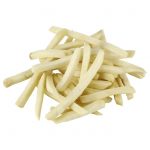 | Classic 6mm, 9mm, 10mm, or 12mm cuts – most common |
Shoestring Fries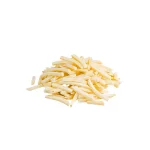 | Thin-cut fries (5–6 mm) – quick fry, crispy texture |
Crinkle Cut | Wavy texture – aesthetic appeal and crunch |
Steakhouse Cut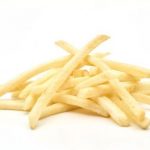 | Thick-cut fries (15–18 mm) – fluffy inside |
Skin-On Fries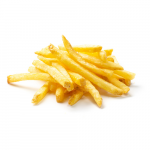 | Rustic look, healthier appeal |
Wedges / Chunky Cuts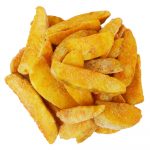 | Large, triangular pieces – seasoned or plain |
Coated Fries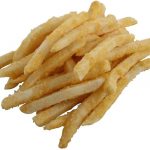 | Battered or seasoned coating for extra crunch and heat retention |
Sweet Potato Fries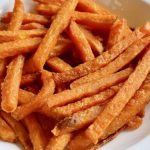 | Sweet potato variant – trendy and healthy |
Curly Fries / Twister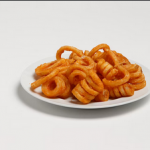 | Spiral shape – kids’ favorite, often seasoned |
Zero-Trans Fat Options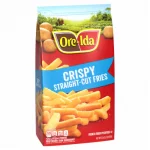 | Health-conscious, no hydrogenated oils |
Organic Fries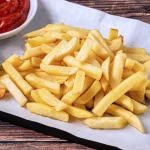 | Made from organically grown potatoes (on request) |
✳️ Cuts available: 6×6 mm, 7×7 mm, 9×9 mm, 10×10 mm, 12×12 mm, 14×14 mm, wedges, julienne
📋 Product Specifications
| Parameter | Value |
|---|---|
| Raw Material | High dry-matter potatoes (e.g. Innovator, Agria) |
| Oil Content | 4–8% (varies by coating) |
| Moisture Content | ≤ 75% |
| Blanching | Yes |
| Pre-frying | Yes (usually in sunflower or palm oil) |
| Freezing Method | IQF |
| Shelf Life | 18–24 months at –18°C |
| Defect Tolerance | ≤ 3% (broken/irregular pieces) |
| Color (fried) | Golden Yellow |
| Texture | Crispy exterior, soft interior |
| Frying Time | 2–4 mins at 175–180°C |
📦 Packaging Options
| Format | Size Range | Use Case |
|---|---|---|
| Retail Bags | 400g – 2.5kg | Supermarkets, frozen food aisles |
| Foodservice Bulk Packs | 2.5kg – 10kg | Restaurants, hotels, fast food |
| Industrial Cartons | 10kg – 20kg | Catering, processing |
| Private Label | Custom sizes | Branded packaging for retail/QSR |
♻️ Biodegradable, recyclable or vacuum packaging on request.
🚚 Logistics & Supply Chain
Origin Countries: Netherlands, Belgium, India, Egypt, USA, China
MOQ: 1 x 20’ FCL (approx. 24–26 MT depending on pack)
Lead Time: 10–15 working days
Export Documentation: CO, Packing List, Health Cert, SGS/BV optional
Main Ports: Rotterdam, Mundra, Antwerp, Qingdao, Alexandria
🍽️ Applications
Quick service restaurants (QSRs)
Cafeterias and airline meals
Home use (oven, fryer, air fryer)
Foodservice and catering
Topped fries (cheese, gravy, spices)
📑 What’s Included
Frozen French Fries (custom cut, coated or plain)
Export documents: CO, Invoice, Health Cert, etc.
Optional: SGS/Intertek/BV Inspection
Private label support
Full compliance with import regulations
❓ FAQs
Q: What’s the best cut for fast food outlets?
A: 9×9 mm or 10×10 mm coated fries are ideal – quick fry time and better heat retention.
Q: Do you offer sweet potato or organic options?
A: Yes, on request we provide organic fries and sweet potato variants.
Q: Can we choose frying oil type?
A: Yes. Most standard is sunflower oil; palm or canola oil can be used upon request.
✅ Why Choose NNRV for Frozen French Fries?
🍟 Premium potato varieties – Sourced from Europe, India, and North America
🌡️ IQF freezing – Lock-in freshness, texture, and color
📦 Retail & Foodservice packs – Tailored to your distribution needs
🌍 Multi-origin sourcing – Year-round availability & price flexibility
🧪 Full quality control – HACCP, BRC, Halal, Kosher, ISO
📜 Export documentation – Smooth, compliant transactions
📩 Request Your Frozen French Fries Quote Today
From QSRs to gourmet kitchens, NNRV delivers crispy, golden fries tailored to your market and prep needs.
📬 [Contact us for samples & pricing]
Frozen French Fries
Introduction: Understanding Frozen French Fries
Frozen French Fries are a processed potato product made from carefully selected varieties. Their quality depends on the variety, farming practices, and industrial processing steps (washing, peeling, cutting, blanching, pre-frying, drying, partial frying, and IQF freezing) followed by proper cold-chain storage.
NNRV supplies frozen French fries tailored for foodservice, retail, and food industry use:
- Formats: straight-cut, crinkle-cut, shoestring, steak fries
- Types: pre-fried (par-fried) and non-pre-fried (IQF blanched)
- Options: conventional, organic, allergen-free
How Frozen French Fries Are Produced
Production combines farming and industrial processing. Main steps include:
- Variety Selection: High-starch potatoes (e.g., Russet, Agria, Maris Piper) for crispy texture and golden color.
- Harvest: Mechanical harvesting at optimal maturity to minimize defects.
- Pre-treatment: Washing, peeling, and optical sorting to remove defects and foreign matter.
- Cutting & Sizing: Industrial cutting into desired shapes (straight, crinkle, shoestring, etc.).
- Blanching: Stabilizes color, deactivates enzymes, and fixes texture.
- Par-frying (optional): Light pre-frying for faster final cooking and crunchier texture.
- IQF Freezing: Individually quick frozen to prevent clumping and preserve freshness.
- Packing & Cold Chain: Packed in retail bags, cartons, or bulk sacks, then stored and shipped at -18°C or below.
Optimal Potato Growing Regions
The best regions combine deep soils, temperate climates, and strong agricultural infrastructure:
Europe
Benelux, France, Germany — loamy soils, mechanized farming, industry-preferred varieties.
Americas
USA (Idaho, Washington), Canada (Saskatchewan), Argentina — large-scale farming and high yields.
Asia
China, India — extensive potato production, supplying both local and global markets.
Other Regions
North Africa and Australia — seasonal supply depending on market demand.
Key factors: microclimate, irrigation control, starch content, and reducing sugars (important to avoid excessive browning during frying).
Practical Considerations for Producers & Processors
- Crop rotation: Prevents soil-borne diseases and preserves soil fertility.
- Seed quality: Certified seed potatoes ensure consistency and high starch levels.
- Sugar control: Proper post-harvest storage to prevent sugar build-up that causes browning.
- Mechanization & automation: Optical sorters, conveyors, and IQF systems ensure efficiency and safety.
- Quality control: Tests for starch, reducing sugar, moisture, frying color, and contaminants.
- Traceability: Full lot identification and food safety certificates.
Why Choose NNRV Frozen French Fries
- Global sourcing from top growing regions
- Organic and conventional options
- Multiple formats for Retail & Foodservice
- Strict quality control (starch, sugar, frying tests)
- Flexible packaging: retail bags, 10–25 kg bulk packs, cartons
- Full cold-chain management and documentation (certificates, COA, microbiological analysis)
Product Specifications (example)
Quality Control & Certifications
NNRV applies a full quality assurance program:
- Laboratory testing: reducing sugars, starch, moisture, residual oil (for par-fried)
- Microbiological tests (Listeria, Salmonella) and HACCP controls
- Optical sorting and visual inspections
- Certifications: ISO 22000, BRC, HACCP, and organic certificates on request
Frequently Asked Questions (FAQ)
- Which potato varieties are best for French fries?
- High-starch varieties such as Russet, Maris Piper, and Agria provide the best frying quality.
- Are the fries pre-fried?
- Both options are available: par-fried for quick finishing, or IQF blanched for custom frying.
- At what temperature should fries be stored?
- At ≤ -18 °C to ensure product safety and shelf life.
- Do you supply organic frozen fries?
- Yes, organic options are available depending on season and origin. Certified documentation provided.
- How does NNRV prevent browning after frying?
- By monitoring reducing sugars, using controlled blanching, and optimized drying methods. Test samples are available.
- What packaging is available for foodservice?
- 10–25 kg sacks, bulk IQF cartons, and private label retail packs.
- What quality documents are provided with each lot?
- Each lot comes with a COA (Certificate of Analysis) including starch, moisture, frying tests, and microbiological analysis.
Order Premium Frozen French Fries Today
Whether for restaurants, retail chains, or food manufacturers, NNRV supplies frozen French fries with full traceability, flexible packaging, and strict quality control.
Frozen French Fries & 40 Finished Products
From Fresh Potatoes to Global Market – Foodservice, Retail, and Industrial Applications
Introduction: Turning Potatoes into Value
Frozen French fries are among the most consumed potato-based products worldwide. Through careful washing, cutting, blanching, frying, and freezing, fresh potatoes are transformed into crispy, long-lasting frozen fries suitable for fast food chains, restaurants, retailers, and export markets. Proper processing preserves taste, texture, and safety while meeting international food quality standards.
Step-by-Step Frozen French Fries Processing
- Raw Potato Selection: High-quality starchy potatoes selected for frying performance.
- Washing & Peeling: Thorough cleaning and mechanical peeling to remove skin.
- Cutting: Potatoes cut into sticks, crinkle, wedges, or specialty shapes.
- Blanching: Hot water or steam treatment to preserve color, remove excess sugar, and improve texture.
- Drying: Surface moisture removed before frying.
- Par-Frying: Partial frying in oil to create flavor and crispness.
- Freezing (IQF): Rapid freezing ensures stability, freshness, and long shelf life.
- Packaging: Packed in retail bags, bulk cartons, or private-label formats with full traceability.
- Quality Control: Size, moisture, texture, oil absorption, and color tested to meet global standards.
- Storage & Logistics: Maintained at –18°C with full cold chain for distribution worldwide.
40 Finished Products Derived from Frozen French Fries
- Straight-Cut Fries – 9mm
- Straight-Cut Fries – 12mm
- Shoestring Fries – thin cut
- Crinkle-Cut Fries
- Steak Fries – thick cut
- Curly Fries
- Waffle Fries
- Potato Wedges – seasoned
- Potato Wedges – unseasoned
- Smiles / Fun Shapes – kids market
- Coated Fries – extra crispy
- Spicy Fries – chili or paprika coating
- Garlic & Herb Fries
- Onion-Flavored Fries
- Sweet Potato Fries – straight cut
- Sweet Potato Fries – shoestring
- Sweet Potato Wedges
- Battered Fries
- Beer-Battered Fries
- Crusty Coated Fries
- Skin-On Rustic Fries
- Low-Fat Oven Fries
- Air-Fryer Optimized Fries
- Organic Frozen Fries
- Halal-Certified Fries
- Kosher-Certified Fries
- Non-GMO Frozen Fries
- Bulk Foodservice Frozen Fries
- Retail Frozen Fries – 1kg packs
- Retail Frozen Fries – 2.5kg packs
- Private Label Frozen Fries
- Value-Added Mixed Vegetable Fries
- Loaded Fries Base (for toppings)
- Frozen Fries for Export – EU
- Frozen Fries for Export – MENA
- Frozen Fries for Export – Asia
- Frozen Fries for Export – Africa
- Customized Cut Fries (by client spec)
- Premium Gourmet Fries
- Specialty Fries for Quick-Service Restaurants
These products serve fast-food chains, hotels, restaurants, supermarkets, distributors, and global importers.
FAQs – Processing & Products
- What makes frozen fries different from fresh fries?
- Frozen fries are pre-cut, partially fried, and flash-frozen to ensure consistent taste, texture, and convenience.
- How are frozen fries kept fresh?
- They are IQF frozen at –18°C and stored under a controlled cold chain.
- Can frozen fries be private-labeled?
- Yes, they can be packaged under your own brand for retail or foodservice markets.
- Are there specialty fries available?
- Yes – organic, coated, seasoned, sweet potato, and premium gourmet variants.
- What is the shelf life of frozen fries?
- 12–18 months when stored at –18°C without breaking the cold chain.
- Which markets demand frozen fries the most?
- QSR chains, supermarkets, hotels, restaurants, and international distributors.
- Can fries be optimized for air-frying or baking?
- Yes, special low-oil and coated varieties are designed for healthier cooking methods.
Frozen French Fries Processing Facilities: 10 Leading Plants, Methods & Financing
Global Production – From Fresh Potatoes to Crispy Frozen Fries for Foodservice and Retail
Introduction: Setting Up and Operating Frozen Fries Plants
Frozen French fries require specialized processing facilities to transform raw potatoes into high-quality frozen products for fast food, retail, and export markets. Efficient plants are designed to maintain crispiness, reduce waste, and comply with international food safety standards. This article explores 10 model frozen fries plants worldwide, their methods, structures, and financing strategies.
Top 10 Frozen French Fries Processing Facilities Globally
- Netherlands – Lamb Weston Meijer
Leading global supplier with advanced automated cutting, blanching, and freezing lines. Serves QSR chains and supermarkets across Europe. ISO 22000 & BRC certified. - Belgium – Aviko
Major EU facility producing coated, seasoned, and organic fries. Focused on retail and export. Fully automated IQF lines and cold chain logistics. - USA – McCain Foods, Idaho Plant
Large-scale production hub for North America. Specializes in straight-cut, crinkle, and premium coated fries. HACCP & USDA certified. - Canada – Cavendish Farms
Integrated facility producing retail, foodservice, and private-label fries. Equipped with water recycling and energy-efficient fryers. - India – Iscon Balaji Foods
Fast-growing facility for domestic and export markets. Produces straight-cut and spiced fries for Asia and Middle East. - Egypt – Farm Frites Egypt
Regional leader for MENA markets. Produces bulk foodservice fries and retail packs with advanced par-frying units. - China – Inner Mongolia Yili Group
Large-scale frozen fries plant with high-capacity IQF lines. Focus on supplying Chinese QSR chains and Asian distributors. - Argentina – McCain Balcarce Plant
Key facility for South America. Produces premium export fries for Latin America, EU, and Asia. - South Africa – Nature’s Garden
Produces frozen fries for Southern Africa with BRC and HACCP certifications. Offers bulk and private-label solutions. - Turkey – Tat Gida
Modern facility producing straight-cut, coated, and spiced fries for Europe, MENA, and Russia. Equipped with advanced packaging and cold storage systems.
Processing Methods Across Facilities
- Washing & Peeling: Automated cleaning and peeling to prepare raw potatoes.
- Cutting: Straight-cut, shoestring, crinkle, wedges, or specialty cuts.
- Blanching: Hot water or steam blanching to stabilize texture and color.
- Drying: Moisture reduction before frying to ensure crispiness.
- Par-Frying: Partial frying in controlled oil systems for consistent taste.
- Freezing (IQF): Rapid freezing at –40°C to lock freshness.
- Coating & Seasoning: Optional flavoring or batter application for added value.
- Packaging: Automatic bagging into retail pouches, bulk cartons, or private-label formats.
- By-product Utilization: Potato peel waste for starch, animal feed, or bioenergy.
- Quality Control: Checks on moisture, oil absorption, microbiology, and sensory attributes.
Typical Plant Structure & Layout
- Raw Material Intake: Potato silos, washing conveyors, and grading units.
- Processing Zone: Peeling, cutting, blanching, frying, and freezing sections.
- Quality & Safety: In-house labs for microbiological and physical testing.
- Packing & Storage: Automated bagging machines, cold rooms, and export-ready warehouses.
- Utilities & Support: Boilers, refrigeration, water treatment, and energy recovery systems.
- Administrative Area: Offices, control rooms, and logistics coordination hubs.
- By-product Management: Starch recovery, waste-to-energy, or animal feed production units.
Financing Frozen Fries Processing Plants
- Equity Investment: Private investors or corporate funds for facility setup and expansion.
- Bank Loans: Term loans or working capital credit lines for equipment and raw potato sourcing.
- Project Financing: Structured financing secured against sales contracts and export receivables.
- Supplier Credit: Deferred payment plans from equipment suppliers or raw material vendors.
- Government Incentives: Subsidies, grants, or tax breaks for food export and agri-processing.
- Joint Ventures: Partnerships with QSR chains, supermarkets, or distributors to share risks.
- Export Credit Agencies: Support for international trade-focused plants with favorable repayment terms.
FAQs – Processing Facilities & Financing
- What is the minimum size for a frozen fries plant?
- Small facilities start at 5–15 MT/day; industrial-scale plants range from 100–1,000 MT/day.
- How much does it cost to build a processing plant?
- Small plants cost $1–3M; large-scale automated facilities may reach $20–50M depending on technology.
- Which countries are favorable for frozen fries production?
- Netherlands, Belgium, USA, Canada, India, Egypt, Argentina, China, South Africa, and Turkey.
- What processing method ensures premium fries?
- Blanching, par-frying, and IQF freezing combined with coating technology for extra crispiness.
- Can by-products generate revenue?
- Yes – potato peel starch, animal feed, and bioenergy solutions add value streams.
- How is product quality maintained?
- ISO/BRC/HACCP certifications, automated QC systems, and sensory testing panels.
- Are joint ventures common in frozen fries processing?
- Yes – collaborations with fast-food chains and supermarkets ensure secure demand and financing.
- Is export financing available?
- Yes – through export credit agencies, project finance, and international trade banks.
- How long does it take to set up a plant?
- 12–24 months for mid-scale facilities; 24–36 months for large industrial plants.
- What environmental considerations apply?
- Water recycling, energy-efficient fryers, starch recovery, and waste-to-energy are essential for compliance.
Global Frozen French Fries Market: Production, Trade, Sustainability & Future Outlook
Top Producers, Exporters, Importers – Quality Control, Traceability & Strategic Insights
Introduction: Why Frozen French Fries Are Critical Globally
Frozen French fries are a major processed potato product, essential for fast-food chains, retail supermarkets, foodservice, and export markets. Growing global demand for convenience foods, crispy snacks, and frozen solutions makes frozen fries increasingly important for food security, trade, and industrial processing.
This article provides an in-depth overview of global production, trade flows, traceability, sustainability, certifications, quality control, and strategic market insights for investors, producers, and buyers.
Top 20 Frozen French Fries Producing Countries (2024 estimates)
- USA – 5.2M MT
- Netherlands – 4.0M MT
- Belgium – 2.5M MT
- Canada – 2.2M MT
- China – 2.0M MT
- India – 1.5M MT
- France – 1.2M MT
- Germany – 1.1M MT
- Brazil – 1.0M MT
- Egypt – 0.9M MT
- Argentina – 0.85M MT
- Turkey – 0.75M MT
- South Africa – 0.7M MT
- Russia – 0.65M MT
- Spain – 0.6M MT
- Netherlands (organic) – 0.5M MT
- UK – 0.45M MT
- Mexico – 0.4M MT
- Poland – 0.38M MT
- Ukraine – 0.35M MT
Top 20 Frozen French Fries Exporters
- Netherlands
- Belgium
- USA
- Canada
- France
- Germany
- China
- India
- Egypt
- Argentina
- Turkey
- South Africa
- UK
- Poland
- Spain
- Brazil
- Mexico
- Ukraine
- Russia
- Australia
Top 20 Frozen French Fries Importers
- European Union (Germany, France, UK)
- USA
- China
- Japan
- South Korea
- Canada
- Saudi Arabia
- UAE
- Mexico
- Brazil
- India
- Australia
- Russia
- Egypt
- Turkey
- South Africa
- Poland
- Netherlands
- Belgium
- Vietnam